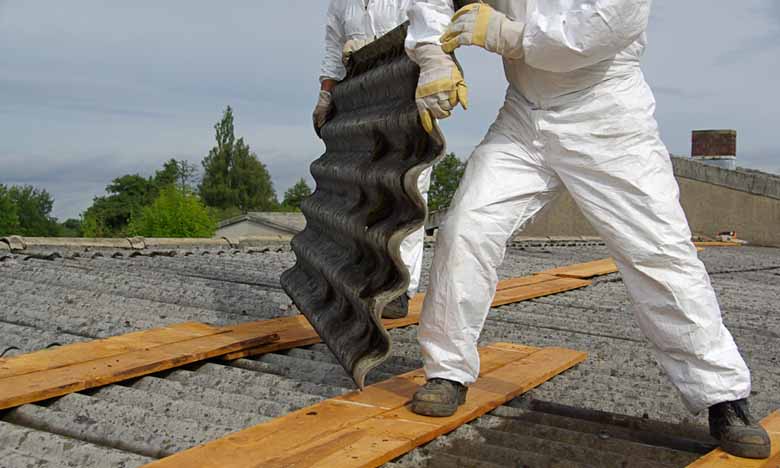During the 1980s and 1990s, asbestos was widely used by the UK construction industry for insulation, roofing, and flooring. It was also sprayed on walls and ceilings as it provided fire protection and sound insulation. However, it was later found that asbestos is extremely harmful to people’s health and banned in 1999.

There are still around 500,000 homes in the UK that have asbestos, so it’s worth checking your home for signs of use.
Our blog post outlines what asbestos is, what it looks like and how to tell if it’s been used in your home.
What is asbestos?
Asbestos is a fibre-like naturally occurring mineral that was widely used in the construction of UK homes before it was banned in 1999. The three most common types used in the UK included:
- Chrysotile (white asbestos)
- Amosite (brown asbestos)
- Crocidolite (blue asbestos)
It was discovered that the fibre increases the likelihood of asbestosis, a serious lung condition. Asbestosis occurs when the surface of asbestos is broken, which results in fibres being released into the air.
It can then be breathed in before entering the lungs and causing long term damage. Symptoms of asbestosis include shortness of breath, a persistent cough and wheezing.
What does asbestos look like?
Asbestos looks either white, brown, or blue in colour and can be soft or hard to the touch depending on what it’s been used for.

In its raw form, as shown above, asbestos can often look like cotton wool with no defined edges and can easily be separated and put back together depending on how much is needed.
Due to it being rarely seen by homeowners, this is the type of asbestos that was commonly used in loft insulation, walls, and underneath flooring.
However, asbestos used to spray walls and ceilings can be much more difficult to identify. Normally it will have an uneven surface and have been painted over.
It’s always worth getting the opinion of a professional asbestos removal expert if you’re unsure if asbestos is in your home.
How can asbestos be correctly identified?
If you suspect that your home might have asbestos because it was built before it was banned in 1999, then it must be identified so it can be removed. This will prevent any potential long term health impacts because of prolonged exposure.
The best way to correctly identify asbestos is to send a sample to a specialist laboratory for testing. This is the only 100% effective way to identify asbestos.
You can do this yourself in around 20 minutes, ensuring you meticulously follow safety precautions.
1) Wear safety equipment
Before you attempt to send an asbestos sample to a lab for testing, you must consider your safety. Wearing safety equipment such as a mask, surgical gloves, goggles and a protective overall will protect you from the effects of asbestos should you encounter it. Once you’ve completed your task, dispose of the equipment to ensure no contamination.
2) Dampen the area
Walk to the area that you believe may be asbestos and dampen it. This will help to prevent fibres from being thrown into the air when you break off a piece. However, it’s important to ensure that your mask and goggles are fully secure, as some fibres might still make their way into the air at different stages of carrying out the task.
3) Remove a piece
Depending on which company you use to test the suspected asbestos, they’ll normally ask you to remove a piece between 2 – 4 square inches in size. This is so they have enough material to carry out several tests. You can remove a piece by using a hammer and chisel. Remember to wash your tools when the job is complete.
4) Secure it
Due to the dangerous nature of asbestos, it’s extremely important that you secure it. The best way to do this is placing it into a clear polythene bag with a grip lock, and then repeating the process once again. Having the potential asbestos in two grip lock bags will ensure that the chances of it being able to escape are minimal. Wash your hands when complete.
5) Send to lab
Following the instructions from the testing company, the final stage is to send your sample to the laboratory. You’ll normally receive a report within the next 7 – 14 days outlining what the material is made from and if asbestos has been found.
If you’re unlucky enough to find asbestos in your garage roof, head over to our garage roof replacement cost guide where we explain asbestos garage roof removal costs.
If you need more advice on asbestos or have any other roofing questions, visit our roofing page for the latest insights and advice.
To get quotes for asbestos removal – post a job now.